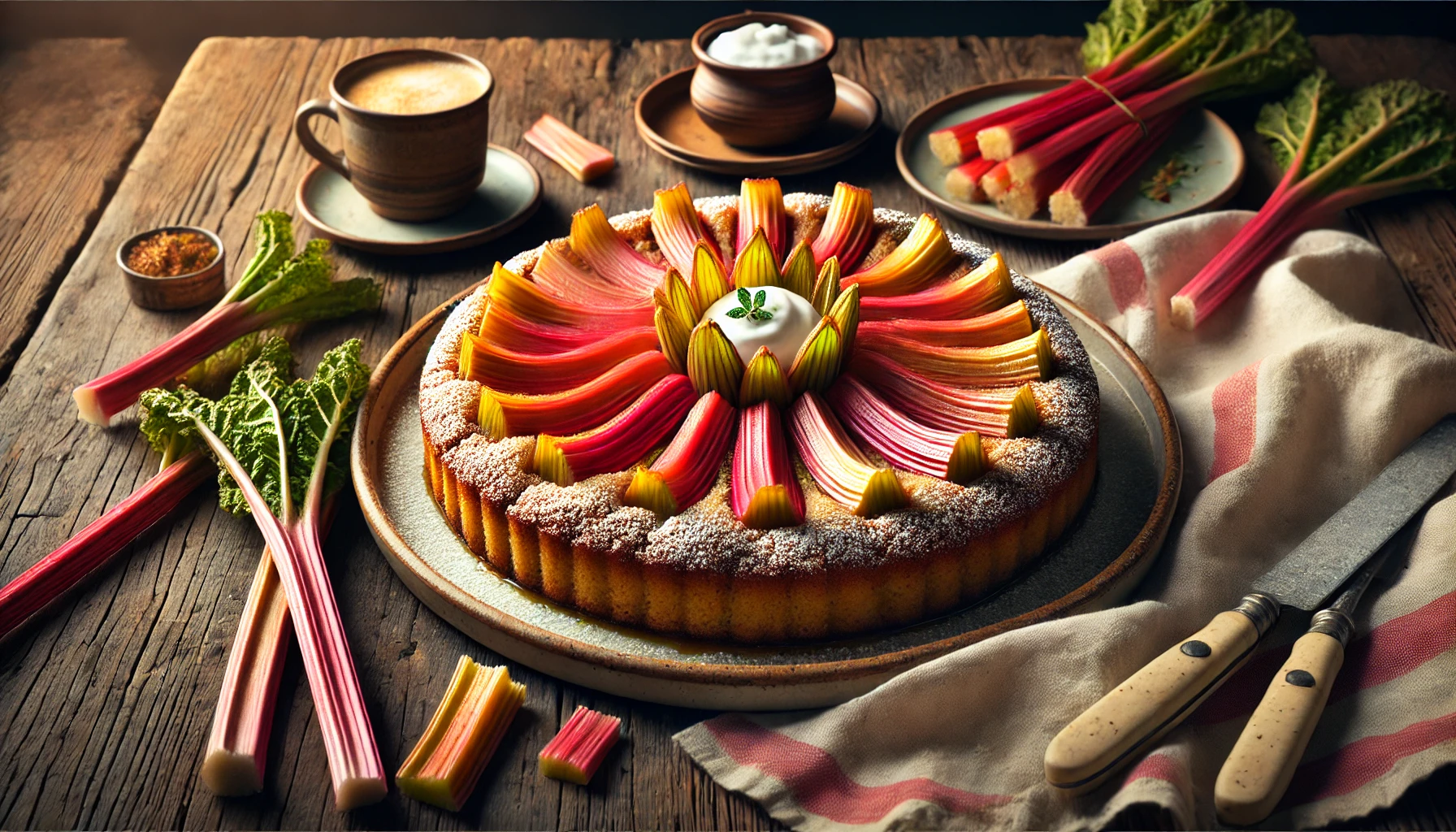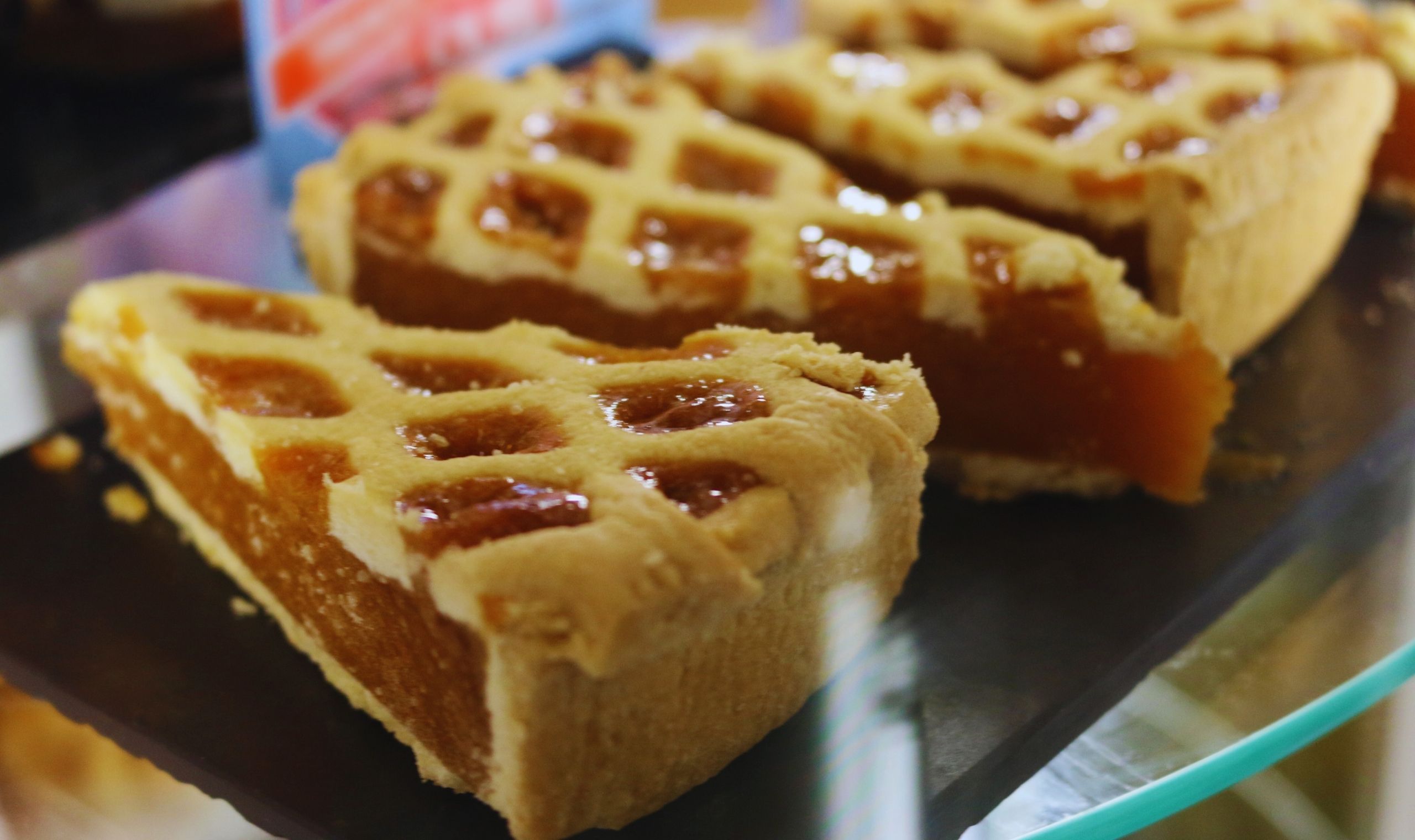A Sweet and Tangy Danish Classic: Rabarberkage
A Slice of Danish Summer
Rabarberkage, or rhubarb pie, is a cherished Danish dessert that captures the essence of summer in Scandinavia. With its tart rhubarb filling and sweet crust, it’s a perfect balance of flavours that has earned its place in Danish kitchens and hearts. This pie is not just a treat; it’s a celebration of the brief yet vibrant growing season of rhubarb in Denmark.
The hallmark of rabarberkage is its simplicity. Danish cuisine often emphasises the natural flavours of its ingredients, and this pie is no exception. The tangy rhubarb filling is sweetened just enough to soften its sharpness, while the crust adds a buttery, crumbly contrast. The result is a dessert that feels indulgent yet refreshingly light.
Rhubarb’s vivid red stalks are as visually appealing as they are flavourful, making rabarberkage a feast for the eyes as well as the palate. Served warm with a dollop of whipped cream or cold with a scoop of vanilla ice cream, it’s a versatile dessert that suits any occasion, from cosy family dinners to festive gatherings.
This pie is more than a dessert—it’s a connection to Denmark’s culinary heritage and the joy of using seasonal produce. Each slice of rabarberkage carries the comforting essence of summer, capturing the fleeting moments of warmth and sunshine in a country known for its long winters.
The History of Rabarberkage
Rhubarb, while not native to Denmark, has been a beloved ingredient in Danish kitchens for centuries. It was first introduced to Europe via trade routes in the 16th century, initially prized for its medicinal properties. By the 18th century, rhubarb was cultivated for culinary use, quickly becoming a favourite ingredient in desserts and preserves across Scandinavia.
Rabarberkage emerged as a staple dessert in Danish households, thanks to the abundance of rhubarb during its growing season from spring to early summer. The pie embodies Denmark’s frugal yet creative culinary traditions, making the most of what the land provides. Its simple ingredients—rhubarb, sugar, flour, and butter—reflect the Danish ethos of hygge, or cosy contentment.
During the 19th and 20th centuries, as baking became more accessible, recipes for rabarberkage appeared in cookbooks, cementing its status as a classic dessert. Variations of the recipe began to emerge, incorporating almonds, marzipan, or custard to enhance the flavour and texture.
Today, rabarberkage is a quintessential Danish dessert, enjoyed by locals and visitors alike. It’s a dish that carries a sense of nostalgia, often linked to childhood memories of summers spent picking rhubarb and baking with family. Its enduring popularity is a testament to its simple yet irresistible charm.
Pairing Drinks with Rabarberkage
The sweet and tangy flavour profile of rabarberkage makes it an ideal companion for a variety of beverages. Whether served warm or cold, the right drink can elevate this dessert into a complete sensory experience.
Coffee is a classic pairing for rabarberkage, as its rich, robust flavours balance the tartness of the rhubarb. A cup of freshly brewed Danish filter coffee or an espresso provides a warm, comforting contrast to the pie’s sweet-tart filling. For a creamier option, a latte or cappuccino works beautifully.
For tea lovers, herbal and floral blends pair particularly well. Chamomile or elderflower tea enhances the natural sweetness of the rhubarb, while a tangy hibiscus tea mirrors its tartness. Black teas, such as Earl Grey or Darjeeling, add a sophisticated touch, making them ideal for afternoon tea gatherings.
On warm days, a chilled glass of white wine or rosé complements the lightness of the pie. A crisp Sauvignon Blanc or a fruity Riesling brings out the rhubarb’s tangy notes, while a sparkling wine adds a celebratory feel. For a non-alcoholic option, elderflower cordial or sparkling water with a slice of lemon offers a refreshing accompaniment.
For a truly Danish experience, pair rabarberkage with a glass of rhubarb juice or a rhubarb-infused cocktail. These drinks echo the pie’s key ingredient, creating a harmonious flavour profile that ties the meal together beautifully.
Five Recipes for Rabarberkage
Traditional Danish Rabarberkage
This classic recipe keeps it simple, highlighting the natural flavours of rhubarb with a buttery crust.
Ingredients:
- For the crust: 250g plain flour, 125g cold butter (cubed), 75g sugar, 1 egg yolk.
- For the filling: 500g rhubarb (chopped), 150g sugar, 2 tbsp plain flour, 1 tsp vanilla extract.
Method:
- Mix flour, sugar, and butter until crumbly. Add the egg yolk and knead until smooth. Chill for 30 minutes.
- Toss rhubarb with sugar, flour, and vanilla extract.
- Roll out the pastry and line a pie dish. Add the rhubarb filling and cover with a lattice or full crust.
- Bake at 180°C for 40–50 minutes until golden. Cool slightly before serving.
Almond and Rhubarb Pie
A luxurious variation with almond cream for added richness.
Ingredients:
- Same crust as the traditional recipe.
- For the filling: 500g rhubarb, 100g sugar, 2 tbsp plain flour.
- For the almond cream: 100g ground almonds, 100g butter, 100g sugar, 1 egg.
Method:
- Prepare the crust and chill.
- Mix rhubarb, sugar, and flour for the filling.
- Cream butter and sugar, then mix in almonds and egg to make the almond cream.
- Line the pie dish with crust, spread almond cream, and top with rhubarb filling. Bake at 180°C for 40 minutes.
Vegan Rabarberkage
A dairy-free and egg-free version that retains the classic flavour.
Ingredients:
- For the crust: 250g plain flour, 100g coconut oil, 75g sugar, 2 tbsp water.
- For the filling: 500g rhubarb, 150g sugar, 2 tbsp cornstarch.
Method:
- Blend flour, sugar, and coconut oil. Add water to bind. Chill for 30 minutes.
- Toss rhubarb with sugar and cornstarch.
- Roll out the pastry, line a pie dish, and add the filling. Cover with a lattice crust. Bake at 180°C for 40–50 minutes.
Rhubarb and Strawberry Pie
A fruity twist combining two seasonal favourites.
Ingredients:
- Same crust as the traditional recipe.
- For the filling: 300g rhubarb, 200g strawberries, 150g sugar, 2 tbsp plain flour, 1 tsp lemon juice.
Method:
- Prepare and chill the crust.
- Mix rhubarb, strawberries, sugar, flour, and lemon juice.
- Assemble the pie with the filling and a lattice top. Bake at 180°C for 40 minutes.
Rhubarb Crumble Pie
A hybrid of pie and crumble, perfect for extra texture.
Ingredients:
- Same crust as the traditional recipe.
- For the filling: 500g rhubarb, 150g sugar, 2 tbsp plain flour.
- For the crumble topping: 100g plain flour, 50g butter, 50g sugar, 25g oats.
Method:
- Prepare the crust and chill.
- Toss rhubarb with sugar and flour for the filling.
- Mix crumble ingredients into coarse crumbs.
- Assemble the pie with the rhubarb filling and top with crumble. Bake at 180°C for 40 minutes.
The Art of Baking Rabarberkage
Baking rabarberkage is an exercise in balance and simplicity. The tartness of the rhubarb must be softened without losing its character, achieved by careful sweetening and seasoning. Using fresh, in-season rhubarb ensures the best flavour and texture.
The crust is equally important. Whether you prefer a buttery shortcrust, a flaky lattice, or a crumble topping, the pastry should complement the filling without overpowering it. Chilling the dough before rolling ensures a tender, flaky result.
The baking process requires attention to detail. The filling should bubble gently, indicating it’s cooked through, while the crust should be golden but not overdone. Letting the pie cool slightly before serving allows the filling to set, making it easier to slice.
Rabarberkage is a testament to the beauty of seasonal baking. Its simple ingredients and straightforward preparation showcase the joy of using fresh, local produce to create something truly special.



